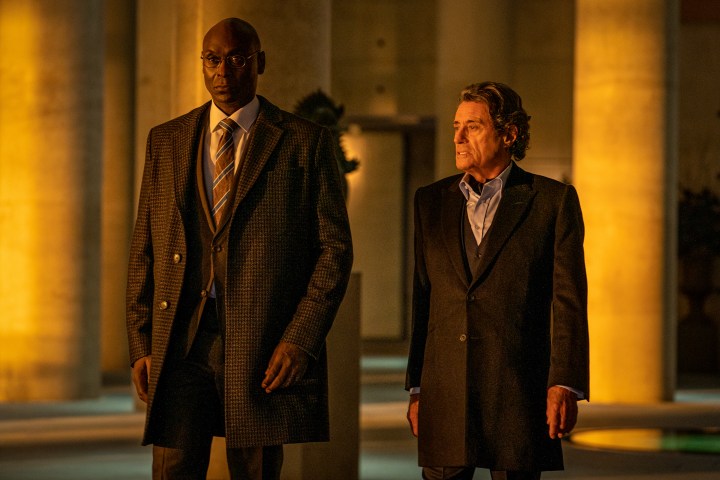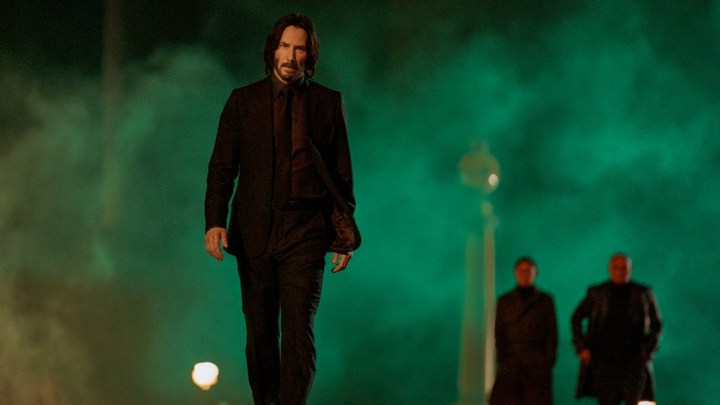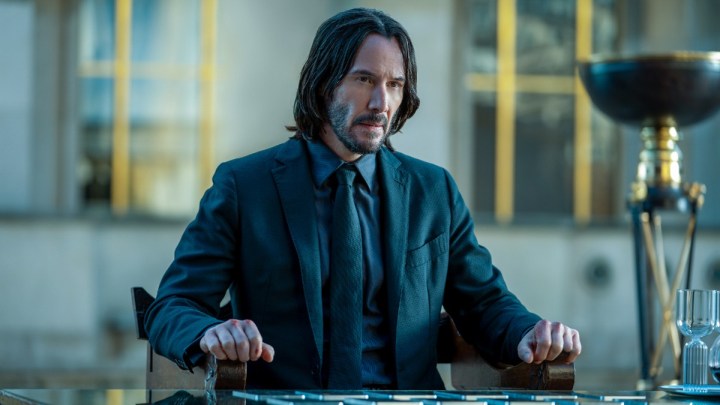Shay Hatten (Day Shift) is quickly becoming one of the most in-demand writers in Hollywood. While interning with Team Downey over six years ago, Hatten wrote Ballerina, a spinoff to the John Wick franchise about a dancer-turned-assassin. After the script was purchased in 2017, Hatten helped co-write John Wick: Chapter 3 – Parabellum. Since then, Hatten has teamed with Zack Snyder (Batman v Superman: Dawn of Justice) to help write Army of the Dead, Army of Thieves, and the upcoming sci-fi epic Rebel Moon. Did I mention that Hatten is not even 30 years old?
The 29-year-old screenwriter returned to the John Wick universe to co-write John Wick: Chapter 4 with Michael Finch. Set after the events of Parabellum, John Wick (The Matrix’s Keanu Reeves) is still alive, hiding beneath the New York City streets with the Bowery King (The Ice Road’s Laurence Fishburne). John is plotting revenge against the High Table while constantly avoiding assassins who seek to eliminate the legendary hitman and collect the high bounty.
John eventually finds a way out of this madness in the form of a duel. If he defeats Marquis Vincent de Gramont (It’s Bill Skarsgård), a senior member of the High Table, in one-to-one combat, John will earn his freedom. However, getting to the duel proves difficult, as assassins from all around the world take their best shot to eliminate John.
In a conversation with Digital Trends, Hatten explains the secret to John Wick, the brilliance of Reeves, and the upcoming spinoff, Ballerina.

Note: This interview has been edited for length and clarity.
Digital Trends: I want to start with how you crafted this story because everyone knows the John Wick films rely on highly choreographed action sequences that are huge in scale. Does [director] Chad [Stahelski] come to you and say, “OK. I have this action sequence in mind. I’m going to set it in Paris.” Then, it’s your job to fill in the dialogue for the scenes before, during, and after. Do you go to him first and say, “Hey, I have this idea that John and Winston are talking before this action sequence.” How does that process go?
Shay Hatten: It’s a constantly evolving process that, I think, comes from both angles. Like a lot of it is that Chad has action sequences he’s been envisioning for a long time and really wants to explore and put in the movie. And then, a lot of it is Keanu has things he’s always wanted to do, but both of them also really understand that, first, it’s about respecting John’s journey. We start working on that at the same time.
I think, ultimately, it builds in both directions where, eventually, we have a good story structure we like, we have a handful of action scenes that we really like, and then we ask ourselves, “How do we throw those together and mix them into the best possible final [version]?” It’s a constantly evolving collaborative process.
John is a man of few words. You have to make his dialogue count. You can’t waste any words. He gets right to the point. What’s the secret to writing John’s dialogue?
The secret is Keanu. I think when I came into the franchise on the third movie, I had a tendency to maybe write too much dialogue for John. Then you sit with Keanu and see him going through the script, and you realize he’s an incredible actor. He’s the most badass presence in film history, and he, better than anybody, has an understanding of how little he needs to say to convey how cool and intimidating this character is. So it’s just basically remembering how awesome Keanu is and what he can do with so little, and that becomes the guiding principle for all of it.
I read that in the first film, there was a five-page scene with dialogue, and Keanu cut it out and replaced it with one line, “Uh huh.”
[Laughs] That sounds right.

How do you keep John vulnerable and not get lost in the action and the set pieces?
Well, I think the key to it, and this is really the key to working on these movies at all, is just remembering the emotional core of John’s journey, which is he’s a guy who really only cares about one thing, which is the memory of his wife. Everything else he cares about — whether it’s his dog, his car, his freedom — are all extensions of his love for his wife. So no matter where this franchise goes, it’s just remembering that that is all he’s trying to service.
You just have to avoid introducing other plot obstacles that would get him away from that. Like if he’s suddenly fighting for something else or has another love interest, I feel those things just run counter to the core of his character. I think as long as you’re on that emotional journey with him, it’s a freedom to do whatever you want with the action around him because you’re going to be on his side.
Which character has been the most challenging to write, and which has been the most fun?
I think Ian McShane’s character [Winston] can be challenging because he’s a character with shifting motivations, where you’re never fully sure where he stands, and John is never fully sure where he stands. But I also think that’s the same answer. That he’s also the most fun to write for because he, more than anybody, embodies this world, where he’s part of the rules of this world. He does have an emotional relationship with John, but also always has his own angle on what he’s trying to get across. He’s the biggest puzzle because he’s such an enigma. But also, you’re getting to write dialogue for Ian McShane, so it’s the greatest thing.
I’m sure having any script made into a movie is an amazing feeling, but with Ballerina, one of your first scripts, on the way, does that feel a little more special?
It feels very special, I’m not going to lie. I think what’s so cool about it is that I’ve written a number of movies at this point, but Ballerina is the first one that’s based on something that I just wrote as an original spec. I was a broke writer, just tapping away at night after my day job, and that was the script I wrote. And then to see it go on this long journey over the years and finally become an actual movie, it really is special. It is like writer’s bucket list stuff, so I’m very, very excited for it to finally get out in the world.
I’m not even going to try and get spoilers out of you, but could you point to one thing about how this film [Ballerina] differs from the John Wick franchise?
Well, what I think is cool is that this centers on a character that came up through the same ballet theater under the tutelage of Anjelica Huston that we see John take a stop at in the third movie. So you realize, “Oh, this character might be someone who shares some similar origin elements with John.” In a cool way, it hints at the backstory for John, but we’re telling it through the lens of a different character.
That’s kind of a jumping-off point, but then it goes to a completely different corner of the world. A whole new community that I think is different than anything we’ve seen in the previous four movies. It starts in the world that you love, and then builds it out and blows the doors off it in a really fun way.

If it’s anything like the John Wick movies, everyone will love it, including me.
I hope so. I don’t want to be the guy who messes it up [laughs].
John Wick: Chapter 4 opens in theaters on March 24.



